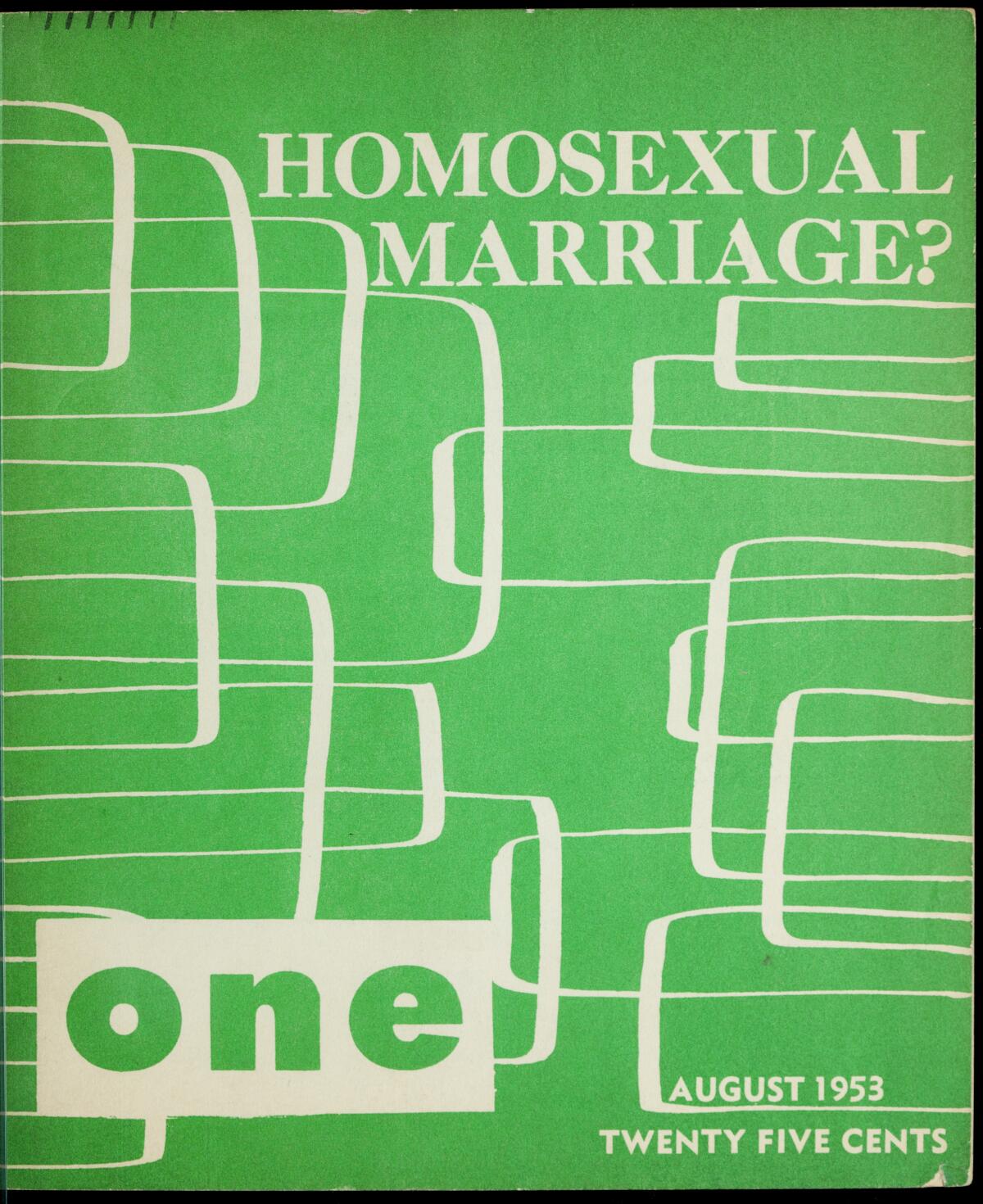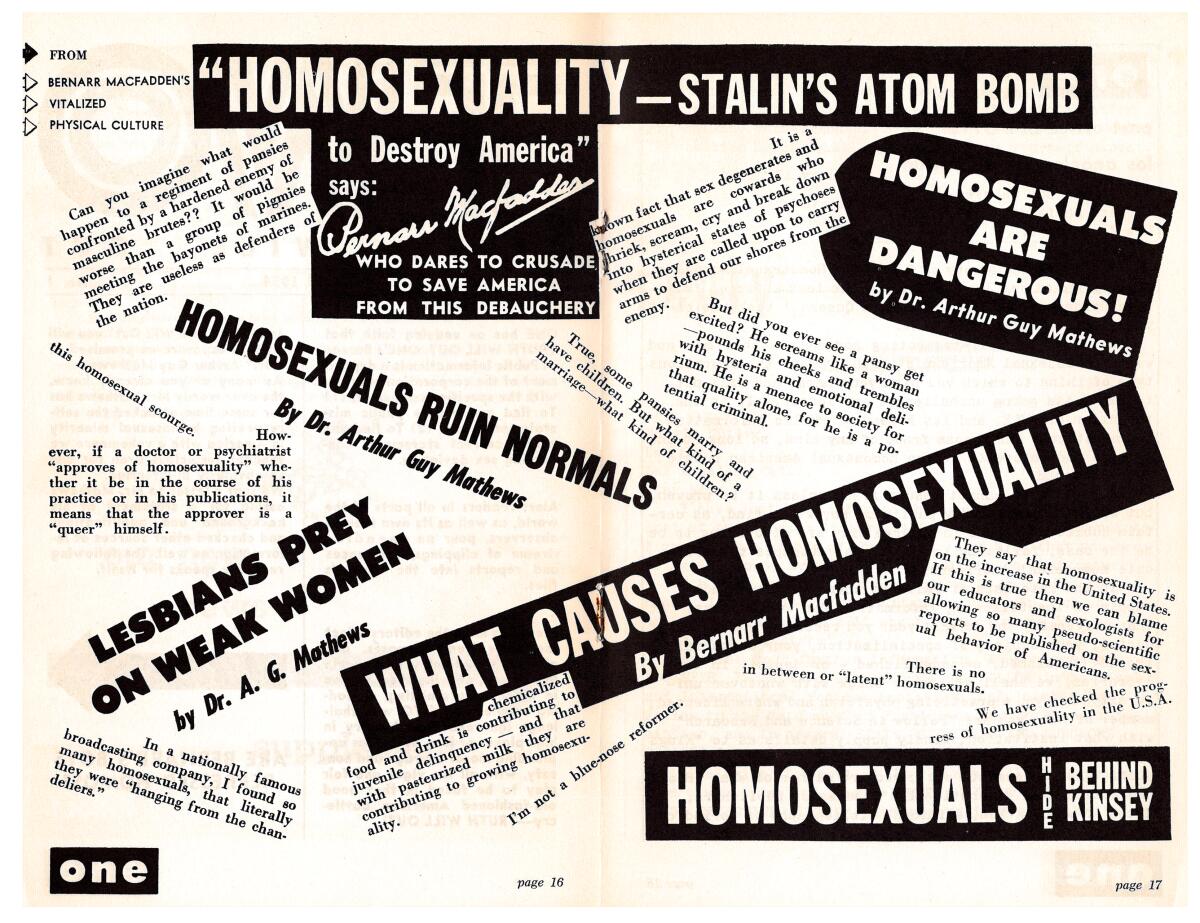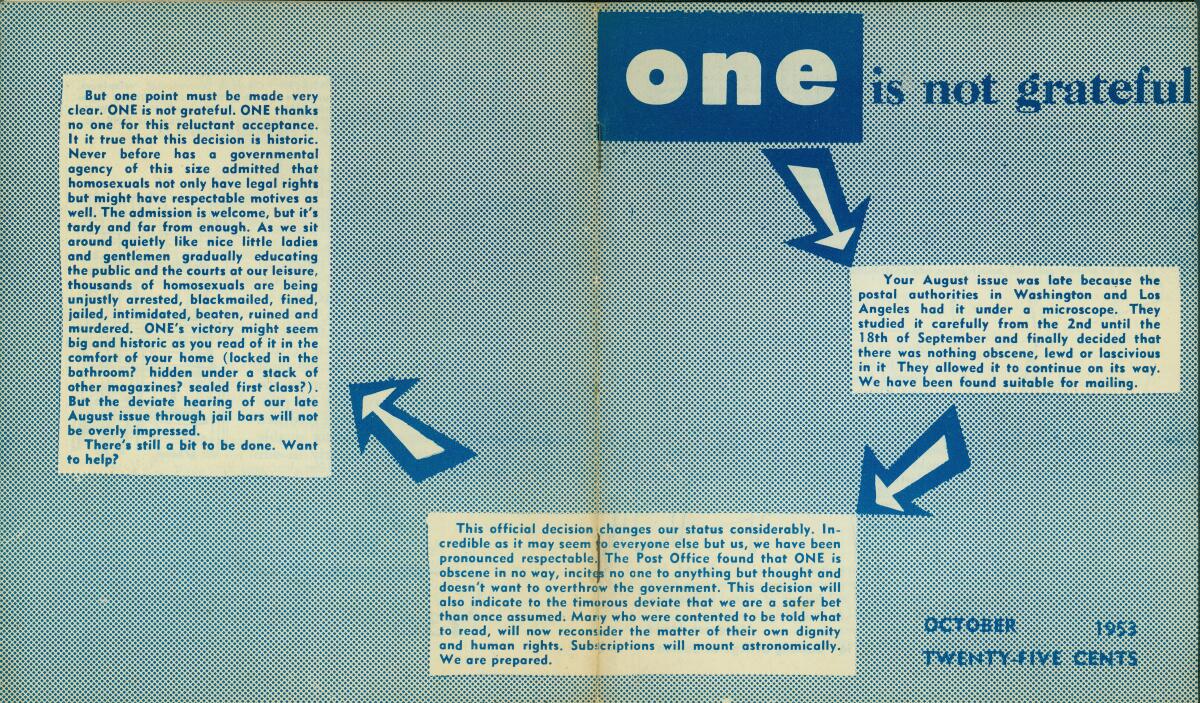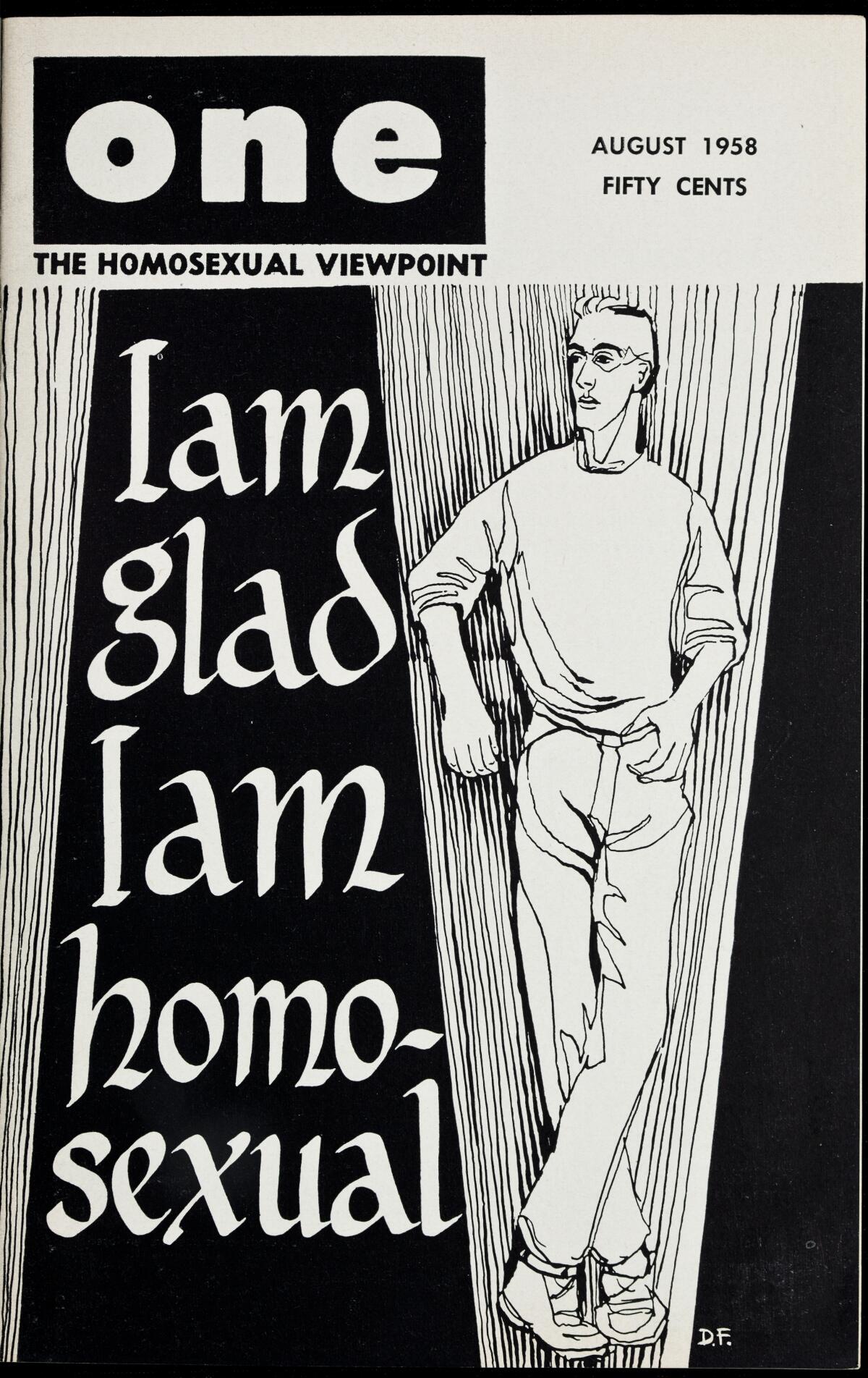One magazine secretly built community in the ’50s. Now it’s celebrated in L.A.’s queer history festival

- Share via
When One magazine published its first issue in January 1953, it became the first widely distributed gay publication in the United States. Created by One Inc., the gay rights organization founded the year before, the pioneering magazine is celebrating its trailblazing pages and its influential 14-year run with a new exhibit in Los Angeles.
Starting Sunday at the Advocate & Gochis Galleries at the Los Angeles LGBT Center, “ONE Magazine at Seventy” offers visitors a chance to dig into the brainchild of writer Jim Kepner and activist W. Dorr Legg. The exhibit kicks off the inaugural “Circa: Queer Histories Festival,” a monthlong celebration of the seven decades of the organization that first founded the storied magazine.
Throughout October, otherwise known as LGBT History Month, and taking place all over the Greater Los Angeles area, Circa will be hosting readings such as “HIV/AIDS: A Literary History” in West Hollywood, panel conversations like “Unapologetically Whole: Queer Elders of Color Speak Out” in Santa Monica, exhibitions such as “Queer Futurism: Transcendence in Time” in the San Gabriel Valley, and film screenings, including of Oat Montien’s “Patpong Narcissus,” at the Tom of Finland Foundation in Echo Park.
For Tony Valenzuela, executive director of the newly rebranded nonprofit One Institute (formerly One Archives Foundation), the exhibit and the Circa festival are attempts to make these various histories be rightly understood as urgent calls to present action.

“What we’re going through — the backlash that LGBTQ people are experiencing today — is the greatest that I’ve seen in my 30-plus-year career,” Valenzuela says. “I mean, not since the dark days of the AIDS epidemic. I haven’t seen such open hatred, such shamelessness around scapegoating queer and especially trans people.”
This was an animating principle for the exhibition curated by Alexis Bard Johnson, Quetzal Arévalo and Sela Kerr. As Johnson explains to The Times, it’s important to situate One’s archives in conversation with contemporary issues. In its heyday, One tackled everything from gay marriage and the Lavender scare (“Are Homosexuals Security Risks?” its October 1960 cover asked readers) to more specific topics (“Must I Answer That Cop?”) about what it meant to live in a society that was openly hostile to so-called perverts and deviants.
Kepner envisioned the publication as arming its readers with the requisite information they needed so as to not feel alone. A column by beloved San Francisco psychologist Blanche M. Baker, for instance, hoped to illuminate “homosexual problems through the psychiatric viewpoint.” Elsewhere, writers like Kepner, Sten Russell (pen name of Stella Rush) and Norman Mailer used the magazine’s pages to illuminate pressing issues that remain all too familiar.
In doing so, One was a rarity at the time. Joseph Hawkins, the director of the One Archives at the USC Libraries, has heard this firsthand from visitors to the archives. Some older folks have openly wept in front of him when faced with copies of the magazine they hadn’t seen in decades. “For them, they were in this complete darkness back then and this was the light that led them out,” he says.

The magazine’s covers, many of which might feel rather staid in 2023, were outright scandalous in the 1950s and 1960s. So much so that readers went out of their way to avoid parading them in public. As Hawkins puts it, “One magazine was a closeted publication.”
“People were afraid to get an envelope that said ‘gay’ or ‘lesbian’ or anything on it,” he adds. “People have told me that they actually put the One magazine into a brown paper bag. They would clutch them to their chest and wait until they got to their apartments. And then read them with the drapes closed and the door closed because they were too paranoid that somebody was going to find out. Because you could lose your job, you could get arrested, all kinds of horrible things could happen.”
The covers are a central part of the “ONE Magazine at Seventy” exhibit. Their monochromatic, often abstracted, imagery (many designed by Eve Ellery) connects the work of early organizations like One Inc., the Mattachine Society and Daughters of Bilitis with the better known activist efforts that would later flourish following the 1969 Stonewall riots.

The October 1953 cover, for instance, served as a two-page spread that explained to its readers why a previous issue had been delayed. “Your August issue was late because the postal authorities in Washington and Los Angeles had it under a microscope,” its text-heavy cover read. The issue was cleared as suitable for mailing. But the magazine’s editorial team made it clear it would not be deterred from continuing its work.
“There’s still a bit to be done. Want to help?” it asked its readers outright. That kind of conversational approach was instrumental in One’s communications strategy.
The magazine spoke directly to its audience. One fostered a broad if fragmented network of readers all over the United States. One built community behind closed doors; something best illustrated by the very personal letters to the editor the magazine made a habit of publishing and responding to, many of which will be on display at this month’s exhibit.

“We’re still fighting the same fights that they were fighting,” Johnson shares. “Obviously we have a different language. We use different terminology. We think about inclusion a bit differently. But there are a lot of ways in which what they were writing about in the magazine and what people were writing into the magazine — the letters — are just still so resonant.”
Another key portion of the exhibit is dedicated to the landmark legal fight between One and the U.S. Postal Service. A year after delaying that August 1953 issue, L.A. Postmaster Otto Olesen declared the October 1954 issue “obscene, lewd, lascivious and filthy.” Attorney Eric Julber, a contributor to One, led the court case all the way to the Supreme Court. There, the eventual 1958 decision in One, Inc. vs. Olesen — the first centered on gay rights — ruled in favor of the L.A.-based publication under 1st Amendment protections.
The road to gay rights at the U.S.
“We have to understand that queer and trans folk have been courageous, creative, resilient people for many decades,” Valenzuela notes with the gritted wistfulness that characterizes “ONE Magazine at Seventy.”
“And yes, we’re facing these really scary challenges. But we’ve been through this before and will remain vigilant. I know we will persevere in these battles because when people know our humanity, we win.”
'ONE Magazine at Seventy'
Where: Advocate & Gochis Galleries at the Los Angeles LGBT Center, 1125 N. McCadden Place
When: Fridays-Sundays, 12-5 PM. Oct. 1–Nov. 5
Info: circafestival.org
More to Read
The biggest entertainment stories
Get our big stories about Hollywood, film, television, music, arts, culture and more right in your inbox as soon as they publish.
You may occasionally receive promotional content from the Los Angeles Times.










